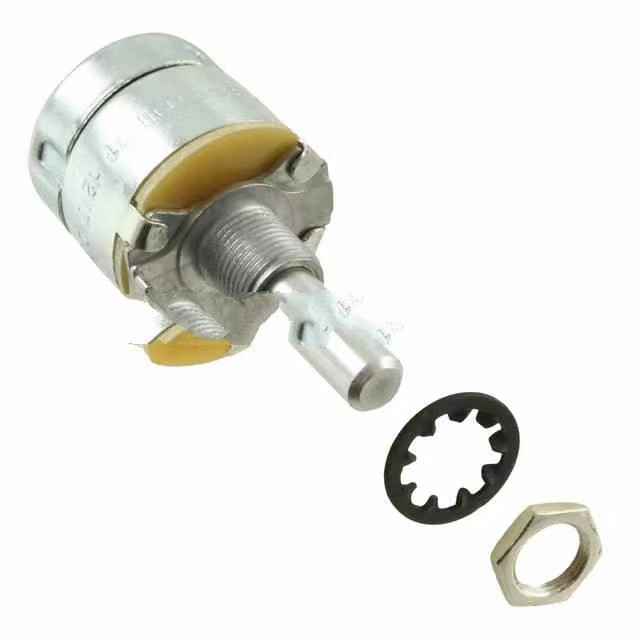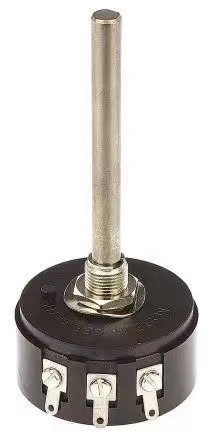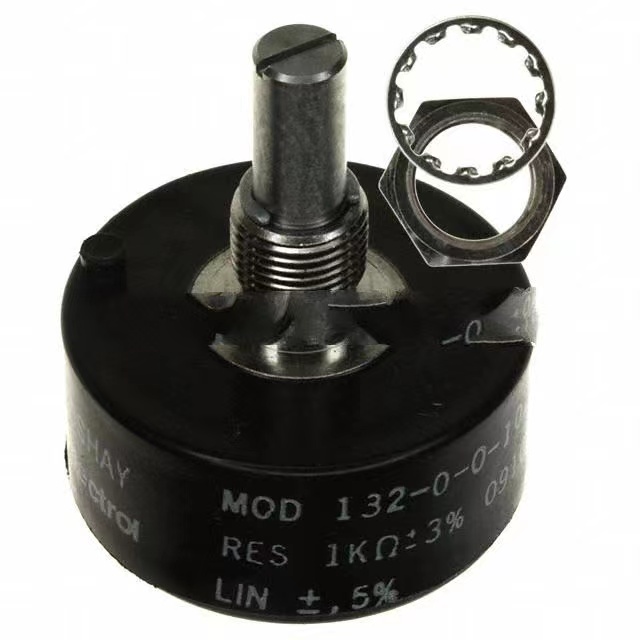What is a rotary potentiometer?

What is a rotary potentiometer?
A rotary potentiometer is a common electronic component used to adjust the value of resistance in a circuit. It consists of a rotating cylindrical shaft with a continuous conductive layer and a fixed ring with movable contacts in contact with the conductive layer. By rotating the shaft, the position of contact between the contact and the conductive layer can be changed, and thus the resistance value can be changed.Since the unit of resistance of the rotary potentiometer is the same as that of the resistor, its unit is also ohm, and the symbol is represented by ω.

How do rotary potentiometers work?
The working principle of a rotary potentiometer is based on the law of resistance in physics. When voltage passes through a resistor, the current flows through the resistor, and the resistance itself blocks the flow of current and converts electrical energy into heat energy and dissipates it. A rotary potentiometer, on the other hand, uses a change in resistance value to generate an electrical signal that acts as a sensor in the circuit. When the knob is rotated, the resistance value on the knob changes, and this change causes a change in the current in the circuit and produces a useful signal.
Rotary potentiometers are often used for functions such as volume adjustment, brightness adjustment, etc., in electronic devices. When the rotary potentiometer is adjusted to the maximum position, the contact is in full contact with the conductive layer, and the resistance value is minimal; When the rotary potentiometer is adjusted to the minimum position, the contact is completely separated from the conductive layer, and the resistance value is maximum. By rotating the potentiometer, we can precisely adjust the resistance value of the circuit to achieve the desired circuit characteristics or functions.
What are the advantages of rotary potentiometers?
- There is no chance of error because it uses the zero-reflection method.
- Normal cells can be normalized directly
- Due to its high sensitivity, it is used to measure small electromotive forces
- Depending on the need, the potentiometer length can be increased to gain accuracy.
- When a potentiometer is used in a circuit to make measurements, it does not draw any current.
What is the disadvantage of rotary potentiometer?
- Potentiometers are inconvenient to use
- The cross-sectional area of the potentiometer wires should be consistent, which is not possible in practice.
- When doing experiments, the wire temperature should be stable, but this is difficult due to the flow of current.
What is the difference between rotary and linear potentiometers?
Linear potentiometers
Linear potentiometers, also known as translational resistors, differ from rotary potentiometers in that they use translational structures. Linear potentiometers are available in single-rail, dual-track, single-channel, and multi-channel versions for different needs, and can be used in a variety of different circuits
Here are the differences between the two:
(1) Good stability: the output voltage of the linear potentiometer has high stability and small fluctuation;(2) Low output noise: The output voltage of the linear potentiometer has low noise, which is suitable for noise-sensitive applications;
(3) Low efficiency: The linear potentiometer has low efficiency and high power consumption, and is suitable for applications with low power requirements.
Rotary potentiometers have the following features:
(1) Large adjustment range: The adjustment range of the rotary potentiometer is relatively large, which is suitable for a variety of occasions with output voltage requirements;
(2) High efficiency: the rotary potentiometer has high efficiency and low power consumption, which is suitable for applications with high power requirements;
(3) High output noise: The output voltage of the rotary potentiometer is noisy, which is not suitable for noise-sensitive applications.
Pros and cons:
Linear potentiometers have the advantage of good stability and low output noise, and are suitable for applications with high requirements for power supply stability and output noise. The disadvantages are low efficiency and high power consumption, which is suitable for applications with low power requirements.
The advantages of rotary potentiometers are their large adjustment range and high efficiency, which makes them suitable for applications with high adjustment range and power requirements. The disadvantage is that the output noise is high, making it unsuitable for noise-sensitive applications.What are the applications of rotary potentiometers?
1. Manufacturing of electronic productsRotary potentiometers are widely used in the manufacture of electronic products, such as televisions, radios, stereos and other household appliances. In these electronic products, rotary potentiometers are often used to adjust parameters such as volume, brightness, contrast, color, etc. In electronics manufacturing, the stability and reliability of rotary potentiometers are very important.
Rotary potentiometers also have important applications in the aerospace sector. For example, rotary potentiometers are used in aviation instrumentation and air conditioning systems to regulate parameters such as altitude, speed, and air temperature of aircraft.
In industrial automation control, rotary potentiometers are used to measure and adjust the working state of the machine. For example, in industrial production lines, rotary potentiometers can be used to control parameters such as temperature, humidity, pressure, flow rate, etc., to ensure product quality and production efficiency. In addition, rotary potentiometers can be used in control systems such as machinery and robots.
In automotive electronic equipment, rotary potentiometers are widely used in automotive engine control, in-car audio adjustment, etc. For example, the control of the accelerator pedal of a car usually uses a rotary potentiometer on the pedal to control the opening of the throttle by rotating the potentiometer to adjust the speed of the vehicle.

Why is a rotary potentiometer called a transducer?
A rotary potentiometer can be considered a sensor because it can transmit useful information by changing the resistance value and functions as a sensing signal in an automatic control system.How do you test a rotary potentiometer?
1. Use a multimeter to measure the resistance valueTo check the quality of the potentiometer, you can use a multimeter to measure, you need to remove the potentiometer from the circuit when measuring, and then connect the two probes of the multimeter to both ends of the potentiometer respectively, if the multimeter shows that the value is within the specified range, the potentiometer is normal. If the multimeter does not display a value or the value changes abnormally, the potentiometer may be faulty.
The rotation potentiometer should be very smooth when rotating, if there is a lag or it does not feel smooth when rotating, it means that there is a problem with the potentiometer. Repair or replacement is required.
If the potentiometer is loose during use, it means that there may be a problem with the structure of the potentiometer or the parts are loose. This is where an inspection is required and a timely fix.
If there is noise or whirring during the use of the potentiometer, it means that there is a problem with the potentiometer. The inside of the potentiometer may be in poor contact or damaged and need to be repaired or replaced.
Carefully observe the appearance of the potentiometer and check whether the potentiometer has obvious deformation, damage, poor contact, etc.
Test the use of potentiometers in different temperatures, humidity and other environments.
What are the causes of rotary potentiometer failure?
Its failure is mostly caused by the following reasons:1. Mechanical failure: including wear and tear of mechanical components, deformation, embrittlement of solder joints, etc.
2. Contact problems: may be caused by grinding powder, oxide film, oil stains, etc.
3. Electrical faults: may be caused by damage to electrical components, fatigue of materials, internal oxidation, open circuits, etc.
Common problems and solutions
1. Poor contact: It may be caused by oxidation, pollution and mechanical wear. The solution is generally to clean the inside of the potentiometer with a special cleaning agent, and it can also be restored by friction and wear.2. Capacitor failure: It may be caused by the aging of the capacitor, internal short circuit, dielectric decomposition, etc. The solution is to replace the capacitor.
3. Mechanical failure: It may be caused by knob falling off, collision, etc. The solution is to replace the potentiometer or repair the mechanical components.
What is the most commonly used potentiometer?
Commonly used potentiometers mainly include single-track potentiometers, double-track potentiometers, rotary potentiometers, sliding potentiometers, linear potentiometers and variable capacitors.Precautions for the use of rotary potentiometers
1. The terminal of the potentiometer should avoid using water-capacitive flux when welding, otherwise it will promote metal oxidation and mold of the material; Avoid using inferior fluxes, as poor soldering may make it difficult to apply tin, resulting in poor contact or open circuits.
2. If the soldering temperature or time is too high or too long, the terminal of the potentiometer may be damaged during soldering. The soldering of the plug-in terminal should be completed within 3 seconds at 235°C±5°C, the soldering should be more than 1.5MM away from the potentiometer body, and the soldering should not use solder to flow through the circuit board, and the soldering of the wire terminal should be completed within 3 seconds at 350°C±10°C. And the terminal should avoid heavy pressure, otherwise it is easy to cause poor contact.
3. When soldering, the height of rosin (flux) entering the printing machine board should be adjusted properly, and the flux should be avoided from invading the inside of the potentiometer, otherwise it will cause poor contact between the brush and the resistor, resulting in INT and bad noise.
4. The potentiometer is best applied to the voltage adjustment structure, and the wiring method should be "1" pin grounding; The use of current-regulated structures should be avoided because the contact resistance between the resistor and the contact piece is not conducive to the passage of large currents.
5. The surface of the potentiometer should avoid condensation or water droplets, and avoid using it in wet places to prevent insulation deterioration or short circuit.
6. When installing the "rotary type" potentiometer to fix the nut, the strength should not be too tight to avoid damage to the screw teeth or poor rotation; When installing a "Straight Slide Type" potentiometer, avoid using long screws, as this may hinder the movement of the slide or even damage the potentiometer itself.
7. In the process of putting the knob on the potentiometer, the thrust used should not be too large (not exceeding the parameters of the push-pull force of the shaft in the specification), otherwise it may cause damage to the potentiometer.
Statement
All articles (images, texts, audio) on this site are uploaded and shared by users, or integrated from relevant internet sources, only for user's learning. If your rights are violated, please contact the administrator to delete! Link to this article: https://www.jinftry.com.
0219-630M│ 0230001-HXW││ 03540539Z│ 0387190076│ 0395077003│ 0395933018│ 04023A5R1DAT2A│ 0416720003│ 0459858271│ 0505Y1500240FQT│ 0505Y1500910FQT│ 06035A7R5B4T2A│ 0603J0630390FFT│ 0746501031│ 08053A101KAT2A│ 08055J180JAWTR│ 0805J0630681GAR│ 0805J1000121JQT│ 0805J5008P20CCR│ 0805Y0635P60CCT│ 0805Y150P200BQT│ 0936000095│ 09694009064│ 1-338168-2│ 1-582553-1│ 1-5KE47CHE3-73│ 1-5KE75CATR│ 10104997-C0C-70DLF│ 103906-7│ 10CL120ZF484I8G│ 1147920000│ 116-93-310-41-006000│ 1206J0250183KCT│ 1206J0501P50CQT│ 1206J0630121MXR│ 1206J1000103MXT│ 1206J2500820FFT│ 1206Y0500471JCR│ 1206Y0505P60DCR│ 1206Y1K58P20CCT│ 1210J0500472MXR│ 1210J1000471GAT│ 1210J1K00100GCT│ 1210Y0160182KXR│ 1210Y1K00180KAT│ 12FL80S05│ 1352110000│ 1544119-2│ 1595690000│ 170M5854│ 171-025-202L031│ 1808J0160564KXR│ 1808J2000562JDT│ 1808J4K00151KXR│ 1808Y0100823JXR│ 1808Y0500820GCR│ 1808Y1000470GFR│ 1808Y2K00151MXR│ 1808Y2K50221FCR│ 1808YA250181JCRSP│ 1808YA250270JCRSPU│ 1812J0500683JXT│ 1812J1000103GFR│ 1812SA560JAT1ASB│ 1812Y0500103FFT│ 1812Y2000102KAR│ 1825J0100103KXR│ 1825J1K20680FCR│ 1825J2000100JCT│ 1825J2K50331MXT│ 1825J6300120KCT│ 1825Y0500221FCR│ 1825Y2K00152MXT│ 1954786│ 1MBI1200UC-120│ 1N4902A-TR│ 1N6020C│ 1N6376HE3-A-D│ 2-644861-5│ 20021111-00018T4LF│ 20021122-00012T1LF│ 20021323-00024D8LF│ 204804-3│ 206G-034-00002N│ 207534-3│ 21010102016│ 2200HT-820-H│ 2220J5000182MDT│ 2220Y0500273JDR│ 2220Y0630333KXT│ 2220Y1K20272MXR│ 2220Y6300102FCT│ 2225J0630223MDR│ 2225J5000334KXT│ 2225Y0160331FFR│ 2225Y1K50150KCR│ 2225Y2000124JDT│ 2225Y2K50122JXR│ 2225Y5000150GCR│ 2225Y6300472JCT│ 2256R-29K│ 2296074│ 2306-H│ 2319498│ 2348-1-00-01-00-00-07-0│ 250S130VZR│ 251R14S0R8AV4T│ 3041927│ 3046443│ 3059Y-1-253M│ 31-5685│ 3120-F304-N7Q1-W19DG4-20A│ 3120-F323-P7T1-W19DG4-6A│ 3152-0-00-01-00-00-08-0│ 3292L-1-104M│ 353NB3C122R│ 353TB3I021T│ 3640JA821JAT9A│ 380LQ561M350A022│ 4-6609929-7│ 40-6575-18│ 400QXW68MEFC12-5X35│ 413402000│ 416F3741XATR│ 431212-21-0│ 43F2K5E│ 449862-6│ 501KAE-ABAG│ 501LCD-ABAF│ 5025851270│ 504JCA-ACAF│ 50TWL2-2MEFC5X11│ 5175474-1│ 51939-258LF│ 5207908-4│ 53313-0865│ 5413631-1│ 5445151│ 5501MBLKRED│ 5714│ 5851313F│ 591QD-BDG│ 5962-8976901RA│ 625│ 630MPB224J│ 637P14836A2T│ 63LSW22000MNB51X83│ 647480-6│ 6561008303F│ 6609105-4│ 6648327-1│ 6735│ 6MBI30FA060│ 70156-1935│ 7101J1V8BE2│ 71920-331│ 71V3556S166PFGI8│ 72V233L6BC│ 74ACT373MSA_98│ 74AHC157PW-118│ 74F20SC_98│ 74LV1T126GW125│ 74VCX162827MTD_98│ 74VHCT373AMTC_98│ 750311271│ 7699-5│ 7705-9│ 77313-424-30LF│ 794489-1│ 7C24500002│ 800USP8P1A1M7RE│ 80G8053│ 831-83-019-10-273101│ 8345-B245-T3M2-DB1B2B-30A│ 850-80-026-40-251101│ 85100RC2255P50│ 855-83-090-10-001101│ 859527-1│ 861400031YO1LF│ 88-569714-15P│ 8D515ZC18SA│ 8D517W26SB│ 8D525S35PN│ 8LT013F26SN-LC│ 8LT717Z26SA│ 8N3DV85AC-0138CDI8│ 8N4Q001LG-0005CDI│ 8T220B39SA-LC│ 8Y32000004│ 9-146285-0-38│ 9-6609942-6│ 91-569721-35S│ 92909-116HLF│ 93939-402HLF│ 93LC86C-E-SN│ 97-3101A28-9PX│ 97-3106B28-6SZ-417-940│ 97-3107B20-17S│ 97-3108B20-24SW-417-940│ 9C08052A27R4FKHFT│







